 |
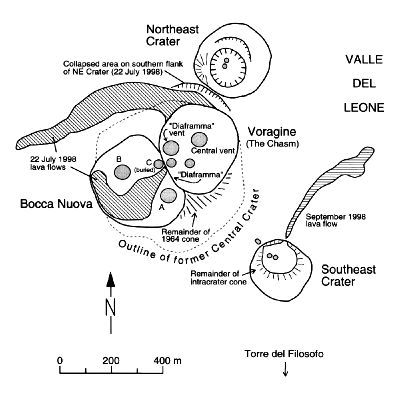
Sketch
map of Etna's summit craters as of 20 September 1998
Many of the
following photos were kindly provided by Sandro Privitera (22-23 July
1998) and Carmelo Monaco (20 August 1998), both of Dipartimento di Scienze
Geologiche of Catania University. Other photos of 22 July 1998 are courtesy
of photographs credited in the captions. Photos are by Boris Behncke unless
otherwise noted; thanks again to Carmelo Monaco for lending me his camera
during my round trip to Bocca Nuova and SE Crater on 20 August 1998.
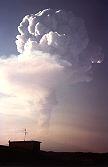 |
The
view from Catania (southern flank)
Left:
Huge mushroom-shaped eruption column rising above Etna's summit
at about 1835 h (local time). The view is from south and was taken
by Sandro Privitera from the balcony
of his home in Catania-Ognina.
Top right: Top of the eruption column, seen from same location.
Photo by Sandro Privitera.
Bottom right: View from the same location of Etna's summit with
continuing, though diminished, ash emission from the Voragine. The
umbrella region of the huge eruption column is still visible in
the upper right portion of the photo. Photo by Sandro
Privitera.
|
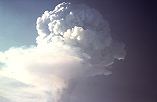
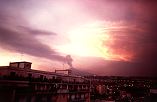 |
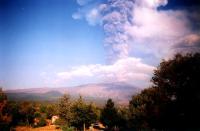
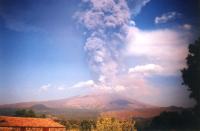 |
The
view from Bronte (western flank)
These three photos
were taken by a photographer working for "Ottica
Mary" of Maria Messina,
Bronte, at intervals ranging from a few minutes to about ten minutes.
Top
left: Shortly after the beginning of the eruption. A part of the
spreading top of the eruption column can be seen at the top of
the image.
Bottom left: The umbrella-shaped cloud at the top of the eruption
column is extending northeastwards while ash is falling to the
south of the eruption column.
Right: Further growth of the eruption column. Dense fallout is
occurring on the southern, and to a lesser degree, on the northern
and eastern sides of the eruption column.
|
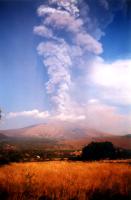 |
|
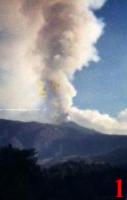
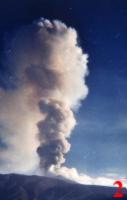
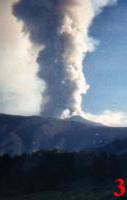
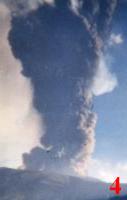
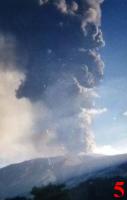
|
The
view from Piano Provenzana (northern flank)
This series was
taken by a person working in one of the tourist shops on Piano
Provenzana, near the hotel "Le Betulle". The images
were taken with an amateur camera and the negatives have suffered
from scratches and dirt (see the yellow dots in the first photo),
but nonetheless render a good idea of the event. Note that these
thumbnails are only small sections of the original photos which
are shown completely in the enlargements. Times when the photos
were taken are not known, but it is assumed that about 15-20 minutes
passed from the first to the last photo.
Photo
1: This photo shows a dense gas plume rising from the Voragine;
the plume contains no ash and may form at the top of a lava fountain.
The steep cone visible at the summit of Etna (at the base of the
plume) is NE Crater which stands in straight line with the Voragine
as viewed from Piano Provenzana. Clouds at right base of the eruption
plume are weather clouds.
Photo 2: The plume rising from the Voragine is getting denser
and is mixing with ash.
Photo 3: As the intensity of the eruption increases, more ash
is rising with the eruption column, and the column is getting
broader as heavy fallout is occurring in the summit area. NE Crater
with its vapor plume is still visible.
Photo 4: The paroxysmal phase of the eruption is now in full swing,
and the eruption column is heavily charged with ash. Note the
dark plume extending at the left base of the main eruption column,
possibly caused by an inclined fountain to the eastern side of
the Voragine (this is probably not a pyroclastic flow). NE Crater
is no longer visible.
Photos 5, 6 and 7: The eruption increases in vigor, and the entire
summit area is concealed by falling pyroclastics.
Photo 8: The eruption column is pitch black, and the summit area
is subjected to heavy fallout.
Photo 9: A panoramic view of the eruption column developing a
mushroom shape. Height of the column above the summit is at least
7 km. A dense pall of fallout extends to the southeast (left of
the eruption column).
One
of the mountain guides working on the northern side of Etna was
near the summit of Etna when the eruption began. First he was
curious to see what was going on at the Voragine and tried to
get closer. As the activity became ever stronger, he felt "real
fear, more than at any other time in many years of working on
Etna" and left the area. Fortunately, there was no one at
the Voragine at the time of the initial explosion which occurred
without any warning - otherwise the eruption would certainly have
killed somebody. The point from which the best view of the Voragine
can be obtained, the southern rim of the NE Crater, was buried
under up to ten meters of agglutinated pyroclastics.
|
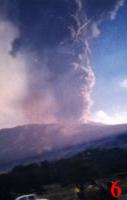
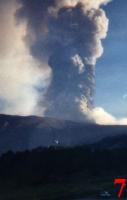
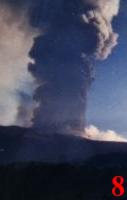
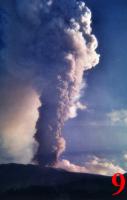 |
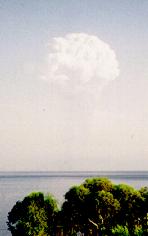 |
Two
spectacular views of the huge mushroom-shaped plume as seen from the
island of Salina (Aeolian Islands), more than 100 km to the north.
The photos were kindly submitted by Paul Oord
and contrast-enhanced to make the plume more apparent. |
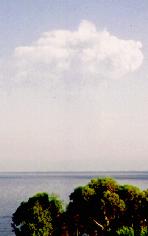 |
|
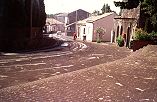


|
Photos
at left:
Top: Street in Milo, on the E flank of Etna, the
morning after the great eruption: ash is lying everywhere, having
a thickness of more than 1 centimeter. Photo by Sandro
Privitera.
Middle: Residents of Milo clearing streets and squares from the
freshly fallen ash, on the morning of 23 July 1998. Photo by Sandro
Privitera.
Bottom: Ash-covered car in a village on the eastern flank of Etna,
23 July 1998. Photo by Sandro Privitera.
Photos
at right:
Top:
Press photo of the Bocca Nuova a few days after the 22 July 1998
eruption, showing the crater floor covered with steaming black lava
that has cascaded into the Bocca Nuova from the Voragine. This photo
was published in the journal "La Sicilia" several weeks after the
eruption but clearly was taken shortly after the eruption.
Bottom: SE Crater in Strombolian activity, with two lava rivers
flowing down its northeastern side, on the evening of 24 July 1998.
This activity ended a few days later, after more than 20 months
of uninterrupted eruptions from the crater; activity resumed on
15 September 1998. Photo scanned from "La Sicilia" of 25 July 1998.
|
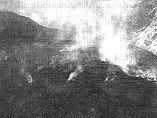

|
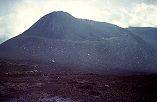

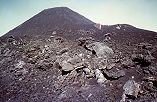
|
Photos
from a summit visit, 20 August 1998
Photos
at left:
Top: View of SE Crater looking down from the southeastern
rim of the main summit cone. Much of the area is mantled with a
thick scoria deposit of the 22 July 1998 eruption. Activity at the
SE Crater ceased in late July 1998, after about 20 months of uninterrupted
Strombolian eruptions and lava effusion.
Middle: Gaping fractures on the eastern side of the former summit
crater, some 100 m southeast of the Voragine. These fractures formed
during the 22 July 1998 eruption but apparently were not the site
of eruptive activity. By the time this photo was taken there were
no emissions from the fractures, but vivid incandescence was visible
within them during the days after the eruption.
Bottom: Intracrater cone of SE Crater viewed from the southwestern
crater rim. Lava and pyroclastics have filled the pre-1996 crater
depression to the rim.
Photos
at right:
Top:
View from the western rim of Bocca Nuova of the lowered "diaframma",
the wall between Bocca Nuova (in the foreground) and Voragine. The
formerly craggy outline of the crest of the "diaframma" has been
smoothed by a vigorous lava flow cascading from the vent behind
it into the Bocca Nuova during the 22 July 1998 eruption.
Middle: Both vent areas of the Bocca Nuova are visible in this image,
taken from the western rim of the crater. TheNW cone with at least
4 vents is at left while the mainly collapsed SE cone is visible
in the right background. The lava flow that cascaded into the Bocca
Nuova during the Voragine eruption of 22 July 1998 is visible as
a chaotic, fractured terrain between the two vent areas and in the
lower right corner of the image.
Bottom: Lava flow (the craggy, light gray-brown streak in the middle
of the photo) erupted from Voragine on 22 July 1998 on the NW side
of main summit cone. This flow, the first from the area of the former
Central Crater (which now hosts both Voragine and Bocca Nuova) since
1964, stopped after crossing the vehicle track that connects the
southern and northern flanks of Etna. In the background the destroyed
southern flank of the NE Crater cone, carried away with the flow
as it streamed out of the Voragine.
|
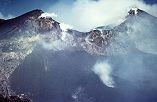
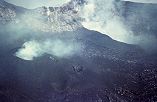
 |
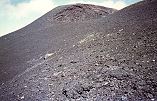 |
Left:
The huge scar carved out of the southern flank of the NE Crater cone
during the lava outflow from the Voragine on 22 July 1998, photographed
on 20 August 1998. The height of the collapsed zone is several tens
of meters.
Right: Zoom of Boris Behncke standing on the southern rim of NE Crater,
with vigorous explosive activity from the two main vents within the
Voragine on 20 August 1998. Ash is exploding from the central vent
while huge bombs are being ejected from the southwestern vent, near
the "diaframma". Photo was taken by Carmelo Monaco. |
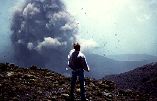 |
|
![]()































